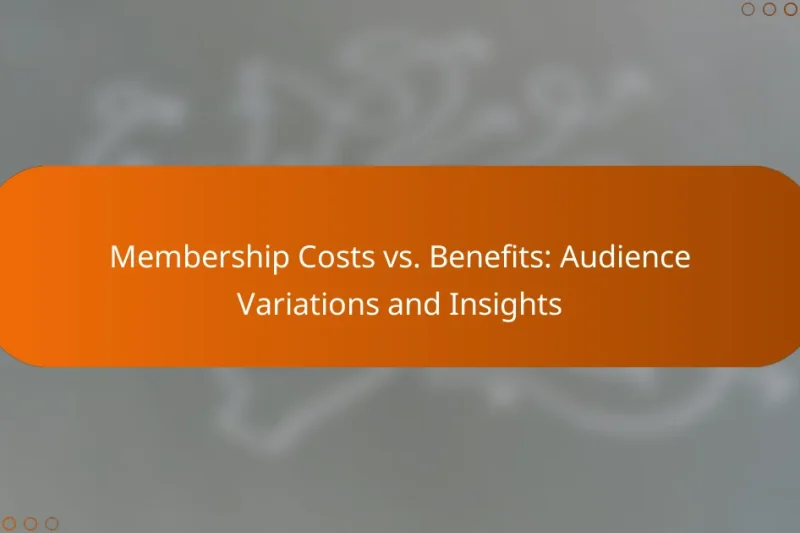When considering membership costs for fitness clubs, it’s essential to recognize the diverse pricing structures that … Membership Costs vs. Benefits: Audience Variations and InsightsRead more
Evaluating Membership Value
Evaluating membership value is crucial for organizations aiming to enhance member satisfaction and retention. By gathering data from various sources and analyzing key metrics, such as retention rates and engagement levels, organizations can better understand member needs and ensure their offerings remain competitive. A strong perception of value fosters loyalty and encourages members to stay engaged over time.
Membership Worth: Investment Criteria and Evaluation
Assessing the worth of membership programs requires a thorough evaluation of investment criteria, including a clear … Membership Worth: Investment Criteria and EvaluationRead more
Membership ROI: Calculation, Impact and Justification
Understanding membership ROI is essential for organizations looking to evaluate the effectiveness of their membership programs. … Membership ROI: Calculation, Impact and JustificationRead more
Member Feedback: Insights, Trends and Value Assessment
Member feedback plays a vital role in refining subscription services by offering direct insights into user … Member Feedback: Insights, Trends and Value AssessmentRead more
Membership Cost-Benefit Analysis: Steps, Tools and Considerations
A membership cost-benefit analysis is a crucial process for assessing the financial and non-financial impacts of … Membership Cost-Benefit Analysis: Steps, Tools and ConsiderationsRead more
Membership Value Assessment: Goals, Metrics and Outcomes
Membership value assessment is essential for organizations aiming to enhance the benefits they provide to their … Membership Value Assessment: Goals, Metrics and OutcomesRead more
Membership Value for Nonprofits: Strategies, Benefits and Challenges
Membership value is essential for nonprofits, as it not only provides financial support but also fosters … Membership Value for Nonprofits: Strategies, Benefits and ChallengesRead more
How to assess membership value effectively?
To assess membership value effectively, focus on gathering data from various sources to understand member needs and satisfaction. This involves using feedback mechanisms, analyzing engagement, and comparing offerings to ensure your membership remains competitive and valuable.
Utilize member feedback surveys
Member feedback surveys are essential tools for gauging satisfaction and identifying areas for improvement. Create short, targeted surveys that ask specific questions about member experiences and expectations. Aim for a response rate of at least 20-30% to ensure your data is representative.
Consider using a mix of quantitative questions (like rating scales) and qualitative questions (open-ended responses) to gather comprehensive insights. Regularly review the feedback to adapt your offerings accordingly.
Analyze engagement metrics
Engagement metrics provide valuable insights into how members interact with your services. Track key indicators such as event attendance, resource usage, and participation in discussions or forums. High engagement typically correlates with perceived membership value.
Utilize analytics tools to monitor these metrics over time, allowing you to identify trends and adjust your strategies. For example, if attendance at webinars is low, consider revising the content or format to better meet member interests.
Compare with competitor offerings
Comparing your membership offerings with those of competitors helps you understand your position in the market. Identify key features, pricing structures, and benefits that competitors provide. This will highlight gaps in your offerings and areas for enhancement.
Conduct a SWOT analysis (Strengths, Weaknesses, Opportunities, Threats) to systematically evaluate how your membership stacks up against others. Regularly update this comparison to stay relevant and competitive.
Evaluate retention rates
Retention rates are a critical indicator of membership value, reflecting how many members continue their subscriptions over time. A high retention rate suggests that members find value in your offerings, while a low rate may indicate issues that need addressing.
Calculate your retention rate by dividing the number of members who renew by the total number of members at the beginning of the period. Aim for a retention rate above 70% as a benchmark for success.
Monitor member satisfaction scores
Member satisfaction scores, often derived from surveys or Net Promoter Scores (NPS), help quantify how members feel about their experience. Regularly measuring these scores allows you to track changes in satisfaction over time.
Set a target satisfaction score and analyze the results to identify trends. If scores drop, investigate the causes and take corrective actions to improve member experiences and perceptions.
What metrics indicate membership value?
Key metrics that indicate membership value include member retention rate, Net Promoter Score (NPS), lifetime value of a member, and engagement levels. These metrics help organizations assess how well they are meeting member needs and the overall effectiveness of their membership programs.
Member retention rate
The member retention rate measures the percentage of members who continue their membership over a specific period. A high retention rate, typically above 80%, indicates strong member satisfaction and loyalty.
To calculate this metric, divide the number of members at the end of a period by the number of members at the start, then multiply by 100. Monitoring retention trends can help identify issues and inform strategies to improve member experience.
Net Promoter Score (NPS)
Net Promoter Score (NPS) gauges member loyalty by asking how likely members are to recommend the organization to others. Scores range from -100 to 100, with higher scores reflecting greater loyalty and satisfaction.
To calculate NPS, survey members and categorize their responses into promoters, passives, and detractors. This feedback can provide insights into areas for improvement and help tailor services to meet member expectations.
Lifetime value of a member
The lifetime value (LTV) of a member estimates the total revenue a member generates throughout their relationship with the organization. Understanding LTV helps organizations allocate resources effectively and justify membership costs.
To calculate LTV, consider average revenue per member, average membership duration, and retention costs. A higher LTV suggests that investing in member engagement and satisfaction can yield significant returns.
Engagement levels
Engagement levels reflect how actively members participate in the organization’s offerings, such as events, forums, or resources. High engagement often correlates with higher retention and satisfaction rates.
To assess engagement, track participation metrics like event attendance, resource usage, and interaction on digital platforms. Regularly analyzing these metrics can help identify trends and areas for enhancing member involvement.
How does membership value impact retention?
Membership value significantly influences retention by fostering a sense of belonging and satisfaction among members. When individuals perceive high value in their membership, they are more likely to remain engaged and continue their subscriptions or memberships over time.
High value leads to increased loyalty
When members recognize the benefits of their membership, such as exclusive content, discounts, or community access, they develop stronger loyalty to the organization. This loyalty often translates into long-term commitment, as satisfied members are less likely to seek alternatives.
Organizations can enhance perceived value by regularly updating offerings and ensuring that members feel appreciated. Simple gestures like personalized communications or member-only events can significantly boost loyalty.
Value perception affects renewal rates
The perception of value directly impacts renewal rates, as members are more inclined to renew when they believe they are receiving adequate benefits. If members feel that the value has diminished, they may reconsider their commitment.
To maintain high renewal rates, organizations should regularly assess member feedback and adapt their offerings accordingly. Providing clear communication about the value being delivered can also help reinforce the decision to renew.
What are the best practices for evaluating membership value?
To effectively evaluate membership value, organizations should focus on assessing member benefits, comparing them to industry standards, and gathering continuous feedback. These practices help ensure that the membership remains relevant and valuable to its members.
Regularly review member benefits
Regular reviews of member benefits are essential to maintain their relevance and effectiveness. Organizations should assess whether the benefits align with member needs and expectations, adjusting them as necessary. Consider conducting annual evaluations to identify which benefits are most utilized and which may need enhancement or replacement.
For example, if a significant number of members are not taking advantage of a specific benefit, it may be time to either improve that offering or replace it with something more appealing. Tracking usage statistics can provide valuable insights into member preferences.
Benchmark against industry standards
Benchmarking membership benefits against industry standards allows organizations to identify gaps and opportunities for improvement. This involves researching what similar organizations offer and comparing those benefits to your own. Understanding the competitive landscape can help ensure that your membership remains attractive.
Utilize surveys and industry reports to gather data on common practices and member expectations. This can help in setting realistic goals for your membership offerings and ensuring they meet or exceed industry norms.
Implement continuous feedback loops
Establishing continuous feedback loops is crucial for understanding member satisfaction and areas for improvement. Regular surveys, feedback forms, and direct communication channels can help gather insights on member experiences and expectations. This ongoing dialogue fosters a sense of community and engagement among members.
Consider creating a simple feedback mechanism, such as quarterly surveys or suggestion boxes, to encourage members to share their thoughts. Analyzing this feedback can guide adjustments to benefits and services, ensuring they remain aligned with member needs.
How to communicate membership value to potential members?
Effectively communicating membership value involves clearly presenting the benefits and outcomes that potential members can expect. Focus on unique advantages, real success stories, and transparent pricing to build trust and interest.
Highlight unique benefits
Identify and emphasize the specific advantages that set your membership apart from others. This could include exclusive access to resources, networking opportunities, or specialized training that members cannot find elsewhere.
Consider creating a comparison chart that outlines these unique benefits against competitors. This visual representation can help potential members quickly grasp what they gain by joining your organization.
Showcase success stories
Sharing testimonials and case studies from current members can powerfully illustrate the value of membership. Highlighting real-life examples of how members have achieved their goals or solved problems through your offerings makes the benefits tangible.
Use various formats such as written testimonials, video interviews, or infographics to cater to different preferences. Ensure these stories are relatable and relevant to your target audience.
Use clear pricing models
Transparent pricing is crucial for potential members to understand the financial commitment involved. Clearly outline membership tiers, what each includes, and any additional costs that may arise.
Consider offering a free trial or a money-back guarantee to lower the barrier for new members. This approach can help them feel more comfortable making a decision, knowing they have options if they find the membership does not meet their expectations.
What challenges arise in evaluating membership value?
Evaluating membership value can be complex due to various challenges, including data collection difficulties, subjective perceptions, and the need for comprehensive metrics. These factors can hinder accurate assessments and make it hard to gauge true member satisfaction and engagement.
Data collection difficulties
Data collection is often a significant hurdle in assessing membership value. Many organizations struggle to gather reliable data due to limited resources, lack of technology, or insufficient member engagement. This can lead to incomplete or biased information, which skews the evaluation process.
To effectively collect data, organizations should consider multiple sources, such as surveys, interviews, and usage analytics. Combining qualitative and quantitative data can provide a more holistic view of membership value. For instance, a survey might reveal member satisfaction, while usage analytics can show how often members engage with services.
Another common pitfall is relying solely on one method of data collection. Diversifying approaches can help mitigate biases and provide a clearer picture. For example, using both online surveys and in-person focus groups can yield richer insights into member experiences and expectations.






